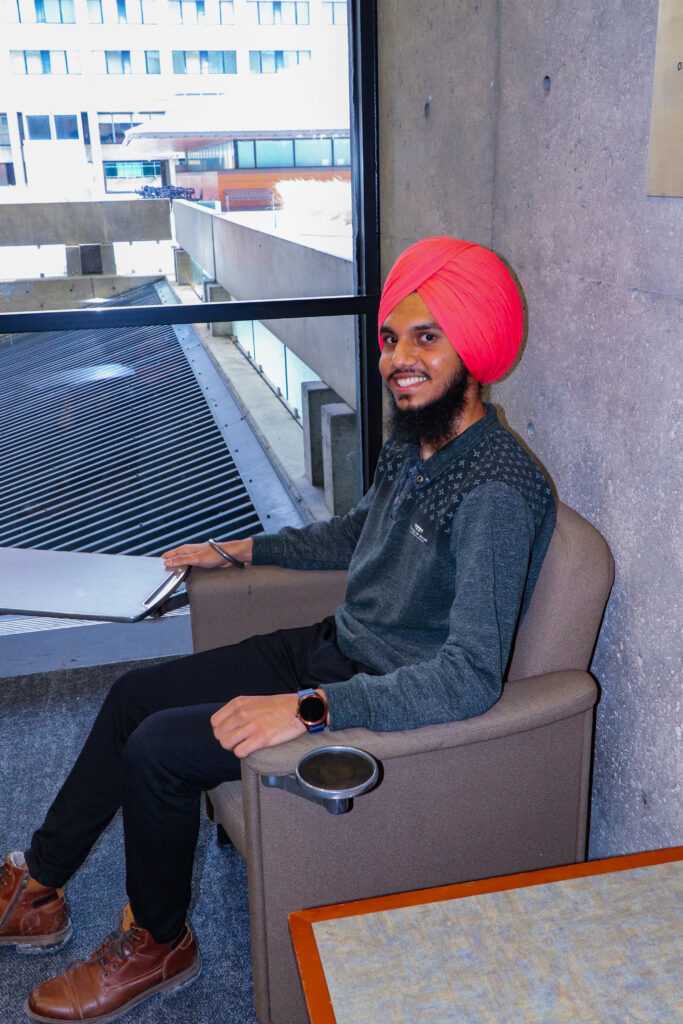By: Parveen Singh
Like many other international students, when Simranjit Singh was looking for opportunities to further his education in 2020, he stumbled upon Seneca @ York. As an Arts and Science student, he immersed himself in not only Seneca College’s community but also the Keele campus’ larger community and didn’t shy away from the thousands of kilometres between him and his goals.
Upon arrival, he quickly understood that he would have to meet vastly different expectations as a student. Being ever the quick- and solutions-oriented thinker he is, Simranjit started leveraging all available opportunities to achieve the success he left his home for, completing his diploma in Arts and Science at Seneca @ York and becoming a student at York University.
Under the same moon and stars whose company he sought in Ahmedabad, India, Simranjit soon came to find Toronto to be his home-away-from-home. Leveraging his positive disposition, Simranjit became increasingly involved in student life at York University.
From being a member of Google Developers Student Clubs to volunteering as an Art Library Assistant at Congress 2023, Simranjit Singh, a second-year Information Studies student at York University, is now contributing to student success with York University Libraries.
(answers edited for clarity)
What is your current role at York University Libraries? How did you come to get involved in student life at YorkU?
I used to volunteer with different committees at YorkU and that’s how I met some of the people at Scott Library. I volunteered at Scott Library first, which was my first opportunity to accrue on the job experience. I work as a Student Success Mentor, and I help students navigate library resources. My job includes creating social media content for the library, and I also help facilitate some events to promote library services.
I met people from the library while volunteering and found them to be very friendly, approachable, caring, and accommodating. I think the environment is very inclusive and comfortable and it’s the kind of experience you want to share with people.
What’s your favourite part about working for York University Libraries?
My favourite part of the job is interacting with the students and creating social media content. I’ve met a lot of good and kind people here. They make me feel like I’m at home. A few of my coworkers feel like brothers to me. Working in the library has also helped me improve my ability to convey information and has bettered my ability to speak in front of a crowd.
Creating social media content was always an interest of mine. Social media helps you connect to a community and to people in general. Working at the Libraries and creating content for them has increased my confidence because sometimes, to become confident, you must do the work first. The confidence comes later.
You’ve travelled quite a long way away from home. What made you choose Seneca College and then York University?
I was looking for a diploma that could be kind of general, and I found Arts and Science at Seneca College, which was good. And it was eligible for university transfer as well, which means that after its completion I can transfer to university. After I transferred to York University, it was the easiest transition because it was the same campus, and I was used to it. I also researched York University and learned that it’s a very reputable university and offered the degree program I was looking for. I’m now in the Information Technology program.
What was the biggest learning curve you faced as an international student who was not only new to post-secondary education but also to the country?
Coming from India, I was not used to citations or the structure of assignments. I also found writing essays challenging because the reading and writing conventions of Indian English are very different from what is expected here. When I was a student at Seneca, I was not aware of the resources and tools that were provided. My volunteer experience at Scott Library led me to discovering that there are services and resources for helping me with these issues. Having someone to approach and connect with has made things a lot easier. Research assistants at the library were the most helpful because I utilized their services that helped me get good grades in my courses.
What is your favourite study spot in the library?
The spaces in the Micro Text area are very quiet and aren’t used by many students. Another spot I really like is the Atrium at Scott Library. It’s right beside the stairs and has a sofa where you can sit and read a book. There’s also a little table attached for you to make notes or enjoy a drink.
What are you currently reading?
I’m currently reading “What to Say When You Talk to Yourself.” It’s about how to tackle the conditioning of your brain. I would really recommend this book to everyone because it presents research that teaches you about your mental programming. From this book, I learned that by the age of 18, you will have been told “no” approximately 148,000 times. When you compare that number to the times you hear “yes” or positive encouragement to accomplish something, the difference is very large. This ends up programming us with an orientation to the negative. Books like this help open your perspective.
“What to say when you talk to yourself” by Margaret Bruzelius is available to borrow in-person and online at York University Libraries.

